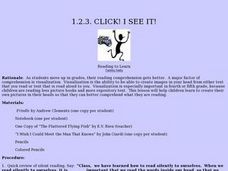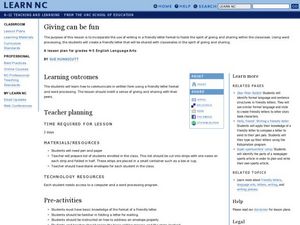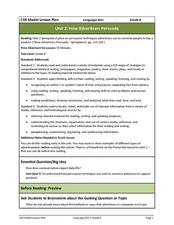Curated OER
I Was Hungry
Students engage in a lesson that focuses on the problem of hunger in the world. They are presented with the concept of being a global citizen. The context of the lesson is the reading of poetry and focusing on the statement "I was...
Curated OER
Best Part of Me
After listening to the story, The Best Part of Me, learners will identify a positive physical feature of themselves, and create a descriptive poem about their favorite feature. Photographs are taken, and a nice final draft of the poem is...
Curated OER
1.2.3. Click! I See It!
Students listen as the teacher reads the poem 'I Wish I Could Meet the Man That Knows' by John Ciardi. They share what they visualized as the teacher read the poem. They practice reading the book "Frindle" silently while creating...
Curated OER
Visualization
Students practice visualization as a strategy to increase reading comprehension. They practice while the teacher reads a poem to them before reading a poem silently to themselves. Next, they practice making mental images while reading a...
Curated OER
Carmel Point
Seventh graders read and analyze the poem "Carmel Point" by Robinson Jeffers. They read the poem online, use an online dictionary to define five words from the poem, and write a weather report summary for the Monterey-Carmel area....
Curated OER
Halloween Crafts and Games
Students access a variety of Halloween themed websites. They locate information on crafts, games and activities relating to Halloween. They complete world problems, write poetry and test reading comprehension.
Curated OER
Giving Can Be Fun!
That it is better to give than receive can be a difficult concept for little ones, especially during the Christmas holiday season. A reading of Jan Brett’s, Christmas Trolls, helps children focus their attention away from what they want...
Curated OER
Picture This!
Young scholars become fluent readers by assessing the strategy of visualization to visualize each event in a story. They use imagery to visualize all types of literature. Each student receives a copy of "Sideways Stories from Wayside...
Curated OER
Genre Study - Grade Three
Third graders learn to identify different types of literature genres. In this genre lesson, 3rd graders complete pre and post- assessment, conduct a genre research activity, and complete the associated worksheets.
Curated OER
Open Sesame: A Magical World of Reading
Third graders, through six lessons, study tales of Ali Baba and the Forty Thieves and Aladdin and the Lamp from The Arabian Nights.
Curated OER
Movies in Your Mind
Students practice visualizing elements from a story. While reading a poem aloud, the instructor models what they see as they read the passage. Students draw a picture of a scene from the book "How to Eat Fried Worms" after reading it...
Curated OER
Analyzing Story Structure
Pupils explore language arts by completing a graphic organizer in class. For this story structure lesson, students read the poem "Sick" by Shel Silverstein and discuss the different elements in the piece which make it an effective...
Curated OER
Stories Aren't Always What They Seem; Or Are They?
Students draw conclusions about a story with examples to support their statements. In this reading comprehension lesson, students look at a PowerPoint of a variety of passages from different books. They answer questions about the...
Curated OER
Understanding Cloud Formation
Students view a demonstration that simulates cloud formation. They read a poem about clouds, participate in a class demonstration using warm water and ice and write a paragraph summarizing their observations.
Curated OER
It's All Poetry to Me!
Fourth graders explore language arts by analyzing poetry styles. In this writing analysis lesson plan, 4th graders read several sample poems in class and identify similes, metaphors and other figurative language within them. Students...
Curated OER
"O Captain! My Captain!"
Who was Walt Whitman, and what link does he have to president Abraham Lincoln? After Lincoln's assassination, Whitman wrote "O Captain! My Captain!" This poem and "When Lilacs Last in the Dooryard Bloom'd" are the focus of...
Curated OER
Primary Sources and Protagonists: A Native American Literature Unit
Introduce your middle schoolers to the lives of past Native Americans. First, learners work together to put photographs in a sequence. Then, using their sequence, they create stories to share with the whole class. No matter how old your...
Denver Art Museum
Descriptive Haiku
Even though this is technically an art activity, haiku poetry is actually the main focus! Learners view photographs of Japanese tea caddies. They list five descriptive words for the caddies, then write haiku poems using the caddies as...
Curated OER
Introduction to Ludwig van Beethoven
"Ode to la Tortilla" and "Ode to Joy"? Sure! Use Gary Soto's poem to introduce learners to the ode format. After examining the descriptive words Soto uses, class members study a poster of Ludwig van Beethoven, suggest words that describe...
Curated OER
How Advertisers Persuade
This plan centers around the article "How Advertisers Persuade," although it is not included in the instructional activity itself. Get your class thinking about advertising, appeals, and techniques that companies use to get their...
Curated OER
"The Clever Monkey"
Second graders complete a variety of activities related to the book "The Clever Monkey" by Rob Cleveland. They answer story comprehension questions, and rewrite the story. Students also complete a comprehension and fact or opinion...
Curated OER
The Outsiders
Are you working on an Outsiders unit? Use this list of activities to deepen your middle schoolers' understanding of the novel. After reading S.E. Hinton's novel, young readers work on three required activities, including participating in...
Curated OER
Post-Colonial Writers Unit
How do cultural and historical background impact thought? To explore this essential question, class members view of portion of the film, The Passage to India, read an excerpt from The Magician’s Nephew, and Nissim Ezekiel’s...
Curated OER
Getting the Meaning in Pop Music
Critical thinkers compare the impact of visual versus aural perception in how they comprehend artistic intent. They consider the meaning of a set of pop lyrics first by reading them, then by listening to them orally, and finally viewing...























